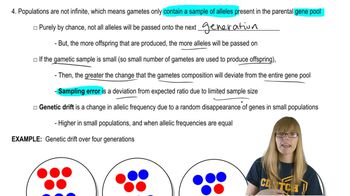Albinism, an autosomal recessive trait characterized by an absence of skin pigmentation, is found in 1 in 4000 people in populations at equilibrium. Brachydactyly, an autosomal dominant trait producing shortened fingers and toes, is found in 1 in 6000 people in populations at equilibrium. For each of these traits, calculate the frequency of the dominant allele at the locus
Table of contents
- 1. Introduction to Genetics51m
- 2. Mendel's Laws of Inheritance3h 37m
- 3. Extensions to Mendelian Inheritance2h 41m
- 4. Genetic Mapping and Linkage2h 28m
- 5. Genetics of Bacteria and Viruses1h 21m
- 6. Chromosomal Variation1h 48m
- 7. DNA and Chromosome Structure56m
- 8. DNA Replication1h 10m
- 9. Mitosis and Meiosis1h 34m
- 10. Transcription1h 0m
- 11. Translation58m
- 12. Gene Regulation in Prokaryotes1h 19m
- 13. Gene Regulation in Eukaryotes44m
- 14. Genetic Control of Development44m
- 15. Genomes and Genomics1h 50m
- 16. Transposable Elements47m
- 17. Mutation, Repair, and Recombination1h 6m
- 18. Molecular Genetic Tools19m
- 19. Cancer Genetics29m
- 20. Quantitative Genetics1h 26m
- 21. Population Genetics50m
- 22. Evolutionary Genetics29m
21. Population Genetics
Hardy Weinberg
Problem 42e
Textbook Question
Put all the candies used in Problems 41 back into a single mound and then divide them into two piles, being sure that the frequencies of each color are the same in each pile. Make a note of the starting frequency of each color. Label one pile 'male' and the other pile 'female.'
Compare the starting frequency of each color with the frequency after drawing. Describe the observed differences and identify the evolutionary mechanism this exercise best emulates.
 Verified step by step guidance
Verified step by step guidance1
Step 1: Begin by gathering all the candies used in Problems 41 into a single mound. Ensure that you have recorded the starting frequency of each color. For example, if you have red, blue, and green candies, note the proportion of each color in the mound (e.g., 40% red, 30% blue, 30% green).
Step 2: Divide the mound into two equal piles, ensuring that the frequencies of each color are the same in both piles. This can be done by carefully counting and distributing the candies so that each pile has the same proportion of red, blue, and green candies as the original mound.
Step 3: Label one pile 'male' and the other pile 'female.' These labels will represent the two groups in the population for the purpose of this exercise.
Step 4: Simulate a drawing process where candies are randomly selected from each pile to form a new generation. Record the frequency of each color in the new generation after the drawing process. For example, if you draw candies randomly, the proportions may shift slightly due to chance.
Step 5: Compare the starting frequency of each color with the frequency observed after the drawing process. Describe any differences in the frequencies and identify the evolutionary mechanism this exercise emulates. This exercise likely demonstrates genetic drift, which is the change in allele frequencies due to random sampling effects in small populations.
 Verified video answer for a similar problem:
Verified video answer for a similar problem:This video solution was recommended by our tutors as helpful for the problem above
Video duration:
2mPlay a video:
Was this helpful?
Key Concepts
Here are the essential concepts you must grasp in order to answer the question correctly.
Genetic Drift
Genetic drift is a mechanism of evolution that refers to random changes in allele frequencies within a population. It is particularly significant in small populations, where chance events can lead to large fluctuations in genetic variation. This concept is crucial for understanding how certain traits may become more or less common over generations, independent of natural selection.
Recommended video:
Guided course

Genetic Drift
Allele Frequency
Allele frequency is the proportion of a specific allele among all allele copies in a population. It is a key measure in population genetics, as it helps to quantify genetic diversity and the genetic structure of populations. Tracking changes in allele frequencies over time can provide insights into evolutionary processes and mechanisms.
Recommended video:
Guided course

New Alleles and Migration
Sexual Selection
Sexual selection is a form of natural selection where individuals with certain inherited traits are more likely than others to obtain mates. This can lead to the development of secondary sexual characteristics and can influence allele frequencies in a population. Understanding sexual selection is essential for analyzing how reproductive strategies affect genetic diversity and evolutionary outcomes.
Recommended video:
Guided course

Natural Selection
Related Videos
Related Practice
Textbook Question
795
views


